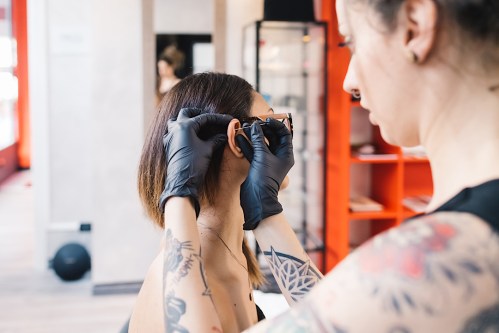Our editors independently select these products. Making a purchase through our links may earn Well+Good a commission
Dermatologists Are Begging You To Read This Before You Get Your Next Piercing
Before you get a new piercing, discover the answer to “What are keloids?” Plus, learn how to avoid this potential side effect.

We’ve reached the age of peak ear piercings. Over the past few years, dazzingly curated stacks and constellation piercings have taken the place of single-studded looks, giving us the chance to artfully decorate our lobes however we see fit. But as much you may love your piercings (and selecting the pretty jewelry to fill them with), your skin isn’t always a fan. Sometimes, it can register a piercing as an injury and make too much scar tissue to compensate, and—boom—a keloid is born. What are keloids, you ask?
Experts in This Article
board-certified dermatologic surgeon at Shafer Clinic Fifth Avenue in New York City
board-certified dermatologist at Medical Dermatology and Cosmetic Surgery in New York
board-certified dermatologist and founder of Maei MD
“Keloids are raised scars that are caused from an overgrowth of scar tissue and can be itchy, tender or painful,” says Dendy Engelman MD, FACMS, FAAD, a board-certified and award-winning dermatologist at Shafer Clinic in New York City. “They can be pink or red in color and are triggered by any type of skin injury that causes the body to overproduce collagen, which is the protein used in wound healing.”
So you can make an informed decision about getting your ears pierced, we spoke to three dermatologists to uncover everything you need to know about keloids.
What are keloids, and why do they occur after piercings?
You may already be familiar with the term keloid from the skin-care world, as these types of scars are often associated with acne. When the skin is injured (which happens when you pop a pimple, or, in this case, when you pierce your skin with a needle), collagen becomes damaged. Your skin cells and connective tissues start to multiply in an attempt to repair that damage, which leads to scarring.
“The body doesn’t know that a piercing is an intentional injury, so the wound healing process kicks into effect and can cause scar tissue to form and keep growing and developing, turning into a keloid,” says Dr. Engelman.
Who tends to develop keloids and why?
“Although it’s not completely known why, keloids are more likely to occur in those with darker skin, with studies showing that keloids are most commonly seen in individuals of African and Asian descent, as well as those of Hispanic and Mediterranean descent,” says Marisa Garshick, MD, FAAD, a leading board-certified dermatologist and assistant clinical professor of dermatology at Weill Cornell Medical Center. In other words, there’s a genetic component at play.
What are the treatment options for keloids?
Keloids are tricky to treat, but there are several treatment options available to get rid of them for good. The hardest part is ensuring that the vicious circle of removing them, causing injury to the skin, and keloid formation potentially re-occurring stops, once and for all.
This Parisian Skincare Brand Is Launching in the United States for the First Time—Here’s What a Derm Wants You to Know

We’re Calling It: Cleansing Balms Are the Face Wash of the Future—Here Are 3 to Add to Your Cart

This Is the One Product That Scarlett Johansson Always Keeps in Her Purse and on Her Bedside Table

So, what choices do you have for treatment?
“In general, keloids are most commonly treated with the use of intralesional injections, using intralesional triamcinolone, a type of steroid,” says Dr. Garshick. “Other treatment options include intralesional injections of a type of chemotherapy known as 5-fluorouracil, silicone gels such as Biocorneum or Silagen, or silicone sheets such as Scarguard.”
Radiation, cryotherapy, lasers, or surgical removal are also options, but Dr. Garshick is hesitant to recommend surgery. “Surgical removal is generally not recommended given the risk of the keloid coming back even larger than before, so if surgery is planned, it is important to treat with radiation or steroid injections immediately after surgery to prevent keloid recurrence,” she says.
If a keloid does start re-forming, it can be retreated with intralesional cortisone injections to reduce its size and symptoms, such as pain and itching.
How can I prevent keloids in the first place?
A good question that comes with a simple, if not so fun, answer.
“If someone is prone to keloids with a family history, it may be recommended to avoid any piercings, tattoos or elective procedures, especially in cosmetically sensitive areas. Common locations for keloids to develop include the ears, neck, arms, legs, upper back, shoulders and chest,” says Dr. Garshick.
Rebecca Marcus, MD, FAAD, a board-certified dermatologist and founder of skin-care brand Maei MD agrees, revealing that proper wound care is important if you do suffer a skin injury.
“Make sure you properly clean any wound, as infection could potentially raise the risk of developing a keloid,” she says. “Try to reduce any tension and stress on the wound as it heals too; as avoiding excessive stretching, movement, or pressure on the affected area can decrease risk of keloid scar formation. Protect any healing wounds from the sun as well.”
One last thing. All of the dermatologists we spoke to mention how important it is to seek treatment sooner rather than later if you notice a keloid forming, as they are much easier to treat in its initial early stages.
So if you notice anything that doesn’t look quite right after your piercing, don’t hold back from making a dermatologist appointment, but otherwise, enjoy your beautiful new piece of body art.
Sign Up for Our Daily Newsletter
Get all the latest in wellness, trends, food, fitness, beauty, and more delivered right to your inbox.
Got it, you've been added to our email list.







